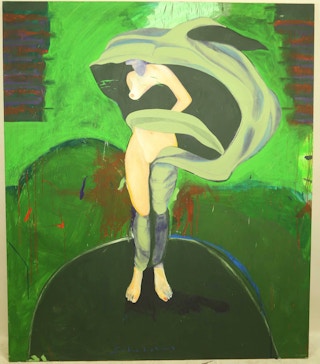Material
Oil Paint, Acrylic Paint
About
Painting of a nude woman wrapped in a cloth against an expressionist green background with accents of red.
Artist Biography
Scholder has always worked in series of paintings. In 1967, his new series on the Native American, depicting the "real Indian," became an immediate controversy. Scholder was the first to paint Indians with American Flags, beer cans, and cats. His target was the loaded national cliché and guilt of the dominant culture. Scholder did not grow up as an Indian and his unique perspective could not be denied. Scholder resigned from I.A.I.A. in 1969 and traveled to Europe and North Africa. He returned to Santa Fe and acquired a small adobe house and studio on Canyon Road. In 1970, Tamarind Institute moved from Los Angeles to Albuquerque. Scholder was invited by Tamarind to do the first major project, a suite of lithographs, INDIANS FOREVER. It was the beginning of a large body of work in that medium for the artist. SCHOLDER / INDIANS was published by Northland Press, the first book on Scholder’s work. In the same year, Scholder had his first one-man show at the Lee Nordness Galleries. He had become a major influence for a generation of native American artists. He was invited to lecture at numerous art conferences and universities including Princeton and Dartmouth College. In 1972 an exhibition of the DARTMOUTH PORTRAITS, opened at Cordier and Ekstrom in New York to favorable reviews. In the same year, Adelyn D. Breeskin of the America Museum of Art of the Smithsonian Institution, visited Scholder and suggested a two-person show of the work of Scholder and one of his former students. Scholder chose T.C. Cannon. The show opened in Washington D.C. to good reviews and traveled to Romania, Yugoslavia, Berlin and London. Scholder was invited to have a one man show at the Basil V International Art Fair in Switzerland in 1974. After Basel, Scholder traveled to Egypt and painted the Sphinx and pyramids.
Dimensions
H 80 in. x W 68 in. X D 2 in.
